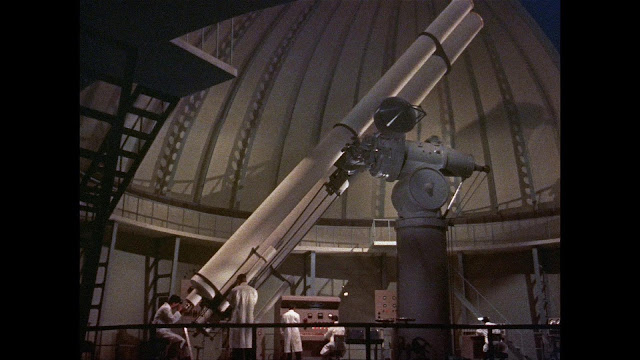Koji Shima's Daiei production Uchûjin Tôkyô ni arawaru ("Space Men Appear in Tokyo," 1956) was not the first Japanese science fiction film - that honor might go to the early Toho production THE INVISIBLE MAN APPEARS, with Eiji Tsubaraya special effects, released in 1949 - but it was the first to be made in color. As a new transcontinental Blu-ray release from Arrow Films demonstrates with impressive clarity, it was a far more important film than was discernible to American audiences when AIP TV belatedly released it directly to television in moderately re-edited form as WARNING FROM SPACE in 1964.
When stacked against Toho's kaiju eiga, with their inclination toward gigantic monsters and cataclysmic spectacle, WARNING FROM SPACE can seem almost quaint with a laughable alien design - but it was coming from a very different place. Anyone with a more than passing interest in science fiction cinema can recognize in its beautiful cinematography certain stylistic quotations from such classic American SF movies as INVADERS FROM MARS (1953) or THE WAR OF THE WORLDS (1954), but it also brings its own bent to the idea of a benign alien visitation to intervene in Mankind's unknowing trespass into a dangerous scientific discovery. The "peaceful invasion" script by Hideo Oguni (surprisingly, the author of numerous Akira Kurosawa films, from THE SEVEN SAMURAI through RAN) certainly owes something to DAY THE EARTH STOOD STILL (1951) but it also looks forward to such properties as the OUTER LIMITS episode "Soldier" (1964) or THE TERMINATOR (1984), in which emissaries from the future travel back to our time to disrupt the research presently in place to launch the world into global war. It's understandable why AIP-TV would retitle the film WARNING FROM SPACE but this sets the viewer up for disappointment, as it's anything but an aggressive film full of interplanetary spectacle. To the contrary, it's a charming, quiet, surreal film packed with marvelous, dream-like images.
 |
| Reversible inner sleeve art. |
 |
| Look closely at the text surrounding this French headline. |
Though Galbraith counts it as a negative, I found Oguni's decision to eliminate the standard hero and heroine (given the absence of real stars) to focus instead on a more general response ultimately a worthwhile and successful experiment, and an interestingly democratic one. It's true that the film doesn't pause to dwell on any individual's backstory for very long, focusing instead on the widespread response to the situation at hand, but even so, the casting shows such acute sensitivity that every character is introduced looking already well lived-in; there is no one in the film's vast cast list that strikes a wrong note. To Western tastes, the idea of the aliens creating a human likeness for themselves after a celebrity showgirl may seem humorous, but the idea is not so far off from what Honda-san himself did with the Princess Selina character played by Akiko Wakabayashi in 1964's GHIDRAH, THE THREE HEADED MONSTER. In this case, the popular dancing showgirl Hikari Aozora is played by Toyomi Karita, who makes an impressive human vessel for the alien addressed as Ginko.
The films are presented in their original 1.37:1 standard ratio with optional English subtitles. While the Japanese version is ravishing in contrast to the reddish 16mm TV prints which have represented the film here for so many decades, the restoration of the English version may be more impressive though it has been (I suspect) assembled from the same pictorial elements. The bump up from 16mm to 35mm HD is stunning from the opening title card. As you might expect, the film's dubbing distorts some of the film's original meaning and it's not quite so coherent as the original, but for many of us, it's the version we grew up with, for better or worse, and its inclusion here is absolutely welcome. Theatrical trailers and a photo gallery are also included.
The commentary by Stuart Galbraith IV - a widely-published authority on Toho Studios, Akira Kurosawa and the kaiju eiga generally - is identified on the packaging as a "select scene commentary," which is not quite accurate as he doesn't address any scenes specifically and there are no programmed stops to help us jump forward or backward to desired topics. Galbraith has a pleasant speaking voice and friendly delivery and speaks continuously for roughly an hour, then stops. While his research is trustworthy, the substance of his talk boils down to a lot of lists - in this case, lists of names, titles, and credits in Japanese. For a commentary that runs short, this is a bit too much - and also too little. His pronunciation is fine but such lists are not very helpful without some additional context brought into it, and are best when left to the printed page. I was also frankly disappointed that he tends to shrug the film off when he makes personal remarks; it is clearly a sincere work crafted with some artistry and it's one that could have benefitted from an observer more willing to engage with its values toward a useful understanding. Fortunately, more help in this regard comes in the 30-page color booklet included with this release, which offers a solid, perceptive overview of the production and Okamoto's involvement by Nick West and a close study of the English version by David Cairns, who tracked down the names of everyone who dubbed it, thanks to inside info from Arianne Ulmer Cipes, the daughter of filmmaker Edgar G. Ulmer and the widow of the track's producer/director Jay Cipes. All well worth reading.
Arrow's WARNING FROM SPACE streets on October 13. It should be noted as one of this year's outstanding film restorations, a thoroughly refreshed presentation that should raise its estimation among science fantasy's fans and historians, young and old.
Subscribe to Tim Lucas / Video WatchBlog by Email
If you enjoy Video WatchBlog, your kind support will help to ensure its continued frequency and broader reach of coverage.







